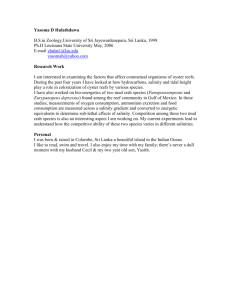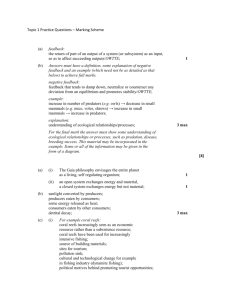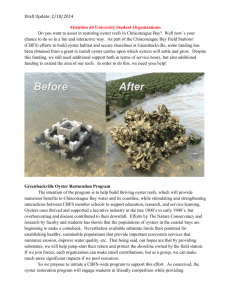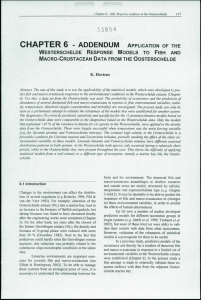THE USE OF AN ECOSYSTEM ENGINEER IN COASTAL DEFENSE
advertisement
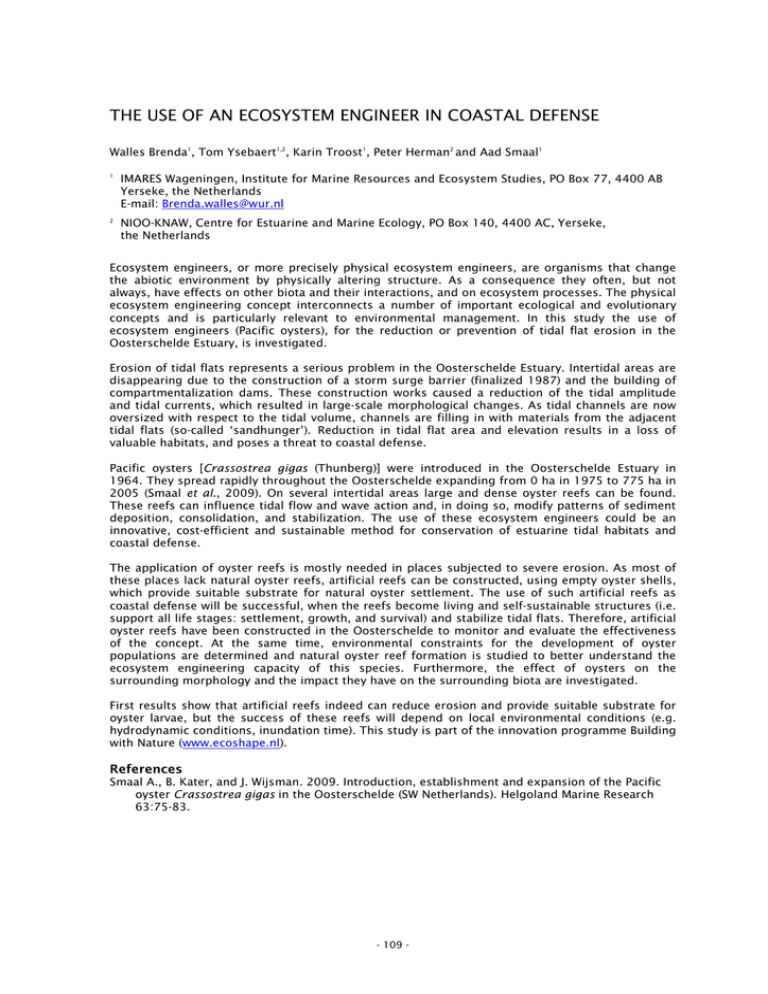
THE USE OF AN ECOSYSTEM ENGINEER IN COASTAL DEFENSE Walles Brenda1, Tom Ysebaert1,2, Karin Troost1, Peter Herman2 and Aad Smaal1 1 IMARES Wageningen, Institute for Marine Resources and Ecosystem Studies, PO Box 77, 4400 AB Yerseke, the Netherlands E-mail: Brenda.walles@wur.nl 2 NIOO-KNAW, Centre for Estuarine and Marine Ecology, PO Box 140, 4400 AC, Yerseke, the Netherlands Ecosystem engineers, or more precisely physical ecosystem engineers, are organisms that change the abiotic environment by physically altering structure. As a consequence they often, but not always, have effects on other biota and their interactions, and on ecosystem processes. The physical ecosystem engineering concept interconnects a number of important ecological and evolutionary concepts and is particularly relevant to environmental management. In this study the use of ecosystem engineers (Pacific oysters), for the reduction or prevention of tidal flat erosion in the Oosterschelde Estuary, is investigated. Erosion of tidal flats represents a serious problem in the Oosterschelde Estuary. Intertidal areas are disappearing due to the construction of a storm surge barrier (finalized 1987) and the building of compartmentalization dams. These construction works caused a reduction of the tidal amplitude and tidal currents, which resulted in large-scale morphological changes. As tidal channels are now oversized with respect to the tidal volume, channels are filling in with materials from the adjacent tidal flats (so-called ‘sandhunger’). Reduction in tidal flat area and elevation results in a loss of valuable habitats, and poses a threat to coastal defense. Pacific oysters [Crassostrea gigas (Thunberg)] were introduced in the Oosterschelde Estuary in 1964. They spread rapidly throughout the Oosterschelde expanding from 0 ha in 1975 to 775 ha in 2005 (Smaal et al., 2009). On several intertidal areas large and dense oyster reefs can be found. These reefs can influence tidal flow and wave action and, in doing so, modify patterns of sediment deposition, consolidation, and stabilization. The use of these ecosystem engineers could be an innovative, cost-efficient and sustainable method for conservation of estuarine tidal habitats and coastal defense. The application of oyster reefs is mostly needed in places subjected to severe erosion. As most of these places lack natural oyster reefs, artificial reefs can be constructed, using empty oyster shells, which provide suitable substrate for natural oyster settlement. The use of such artificial reefs as coastal defense will be successful, when the reefs become living and self-sustainable structures (i.e. support all life stages: settlement, growth, and survival) and stabilize tidal flats. Therefore, artificial oyster reefs have been constructed in the Oosterschelde to monitor and evaluate the effectiveness of the concept. At the same time, environmental constraints for the development of oyster populations are determined and natural oyster reef formation is studied to better understand the ecosystem engineering capacity of this species. Furthermore, the effect of oysters on the surrounding morphology and the impact they have on the surrounding biota are investigated. First results show that artificial reefs indeed can reduce erosion and provide suitable substrate for oyster larvae, but the success of these reefs will depend on local environmental conditions (e.g. hydrodynamic conditions, inundation time). This study is part of the innovation programme Building with Nature (www.ecoshape.nl). References Smaal A., B. Kater, and J. Wijsman. 2009. Introduction, establishment and expansion of the Pacific oyster Crassostrea gigas in the Oosterschelde (SW Netherlands). Helgoland Marine Research 63:75-83. - 109 -
